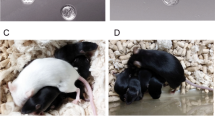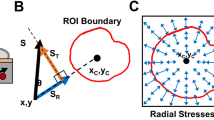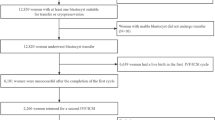Abstract
Objective
This study aimed to investigate the influence of different culture media on early embryonic cleavage kinetics using time-lapse analysis and to determine the possible relationships between energy substrates in culture media and the cleavage kinetics.
Methods
A total of 10 021 embryos from 1310 couples were cultured in time-lapse incubators. Embryos cultured in Vitrolife media were allocated to group I, and those in COOK media to group II. Embryo cleavage time points up to the 8-cell stage (t2–t8) were observed after pronuclei fading.
Results
The baseline demographic features, in vitro fertilization indications, ovarian stimulation protocol, oocyte-cumulus complexes, fertilization rate, together with pregnancy and perinatal outcomes were similar (P>0.05) between groups I and II. According to the time-lapse analysis, all embryos in group I showed significantly faster cleavage speed than those in group II (P<0.05). Furthermore, there was better synchrony in division (s3) and a longer length of the third cell cycle duration (cc3) in group II. Interestingly, implanted embryos in group II showed faster cleavage speed than those in group I, especially at t4 and t7. The glucose contents and multiple major amino acids were similar between the two groups. Lactic and pyruvic acid contents were generally higher in group I than those in group II.
Conclusion
Because different commercial culture media may influence cleavage kinetics of embryos, it is essential for embryologists to take culture media into consideration in selecting a potential embryo when using a time-lapse system before implantation.
Similar content being viewed by others
References
Faddy MJ, Gosden MD, Gosden RG. A demographic projection of the contribution of assisted reproductive technologies to world population growth. Reprod Biomed Online, 2018,36(4):455–458
Zhu L, Zhang Y, Liu Y, et al. Maternal and Livebirth Outcomes of Pregnancies following Assisted Reproductive Technology: A Retrospective Cohort Study. Sci Rep, 2016,6:35141
Vergouw CG, Kostelijk EH, Doejaaren E, et al. The influence of the type of embryo culture medium on neonatal birthweight after single embryo transfer in IVF. Hum Reprod, 2012,27(9):2619–2626
Mantikou E, Youssef MA, van Wely M, et al. Embryo culture media and IVF/ICSI success rates: a systematic review. Hum Reprod Update, 2013,19(3):210–220
Chronopoulou E, Harper JC. IVF culture media: past, present and future. Hum Reprod Update, 2015,21(1):39–55
Carrasco B, Boada M, Rodriguez I, et al. Does culture medium influence offspring birth weight? Fertil Steril, 2013,100(5):1283–1288
Morbeck DE, Krisher RL, Herrick JR, et al. Composition of commercial media used for human embryo culture. Fertil Steril, 2014,102(3):759–766
Pribenszky C, Losonczi E, Molnar M, et al. Prediction of in-vitro developmental competence of early cleavage-stage mouse embryos with compact time-lapse equipment. Reprod Biomed Online, 2010,20(3):371–379
Pribenszky C, Matyas S, Kovacs P, et al. Pregnancy achieved by transfer of a single blastocyst selected by time-lapse monitoring. Reprod Biomed Online, 2010,21(4):533–536
Goodman LR, Goldberg J, Falcone T, et al. Does the addition of time-lapse morphokinetics in the selection of embryos for transfer improve pregnancy rates? A randomized controlled trial. Fertil Steril, 2016,105(2):275–285
Trinh T, Desai N, Goldberg J. Use of timelapse and kinetic markers to compare two different one-step IVF culture. Fertil Steril, 2012,98(3):S167–S168
Huang B, Qian K, Li Z, et al. Neonatal outcomes after early rescue intracytoplasmic sperm injection: an analysis of a 5-year period. Fertil Steril, 2015,103(6):1432–1437
Huang B, Li Z, Zhu L, et al. Progesterone elevation on the day of HCG administration may affect rescue ICSI. Reprod Biomed Online, 2014,29(1):88–93
Huang B, Ren X, Wu L, et al. Elevated Progesterone Levels on the Day of Oocyte Maturation May Affect Top Quality Embryo IVF Cycles. PLoS One, 2016,11(1):e0145895
Wilson A, Work T, Bushway A, et al. HPLC determination of fructose, glucose, and sucrose in potatoes. J Food Sci, 1981,46(1):300–301
Zhou C, Ma X, Chen J, et al. Untargeted metabolomics and lipidomics analysis identified the role of FOXA1 in remodeling the metabolic pattern of BaP-transformed 16HBE cells. Toxicol Appl Pharmacol, 2021,426:115640
Zhao C, Guo Y, Wang R, et al. Effect of hydrogen-rich water on the lactic acid level in metformin-treated diabetic rats under hypoxia. Korean J Physiol Pharmacol, 2021,25(6):517–523
Kleijkers SH, van Montfoort AP, Smits LJ, et al. IVF culture medium affects post-natal weight in humans during the first 2 years of life. Hum Reprod, 2014,29(4):661–669
Zandstra H, Van Montfoort AP, Dumoulin JC. Does the type of culture medium used influence birthweight of children born after IVF? Hum Reprod, 2015,30(3):530–542
Smith GD, Takayama S, Swain JE. Rethinking in vitro embryo culture: new developments in culture platforms and potential to improve assisted reproductive technologies. Biol Reprod, 2012,86(3):62
Lane M, Gardner DK. Differential regulation of mouse embryo development and viability by amino acids. J Reprod Fertil, 1997,109(1):153–164
Lane M, Gardner DK. Nonessential amino acids and glutamine decrease the time of the first three cleavage divisions and increase compaction of mouse zygotes in vitro. J Assist Reprod Genet, 1997,14(7):398–403
Wong CC, Loewke KE, Bossert NL, et al. Non-invasive imaging of human embryos before embryonic genome activation predicts development to the blastocyst stage. Nat Biotechnol, 2010,28(10):1115–1121
Kleijkers SH, van Montfoort AP, Bekers O, et al. Ammonium accumulation in commercially available embryo culture media and protein supplements during storage at 2–8°C and during incubation at 37°C. Hum Reprod, 2016, 31(6):1192–1199
Lane M, Gardner DK. Embryo culture medium: which is the best? Best Pract Res Clin Obstet Gynaecol, 2007,21(1):83–100
Lane M, Gardner DK. Ammonium induces aberrant blastocyst differentiation, metabolism, pH regulation, gene expression and subsequently alters fetal development in the mouse. Biol Reprod, 2003,69(4):1109–1117
Gardner DK, Hamilton R, McCallie B, et al. Human and mouse embryonic development, metabolism and gene expression are altered by an ammonium gradient in vitro. Reproduction, 2013,146(1):49–61
Dumoulin JC, Land JA, Van Montfoort AP, et al. Effect of in vitro culture of human embryos on birthweight of newborns. Hum Reprod, 2010,25(3):605–612
Wunder D, Ballabeni P, Roth-Kleiner M, et al. Effect of embryo culture media on birthweight and length in singleton term infants after IVF-ICSI. Swiss Med Wkly, 2014,144:w14038
Nelissen EC, Van Montfoort AP, Coonen E, et al. Further evidence that culture media affect perinatal outcome: findings after transfer of fresh and cryopreserved embryos. Hum Reprod, 2012,27(7):1966–1976
Author information
Authors and Affiliations
Corresponding authors
Ethics declarations
The authors declare that they have no competing interests.
Additional information
This study was funded by the National Natural Science Foundation of China (No. 82004017 and No. 81801531).
Rights and permissions
About this article
Cite this article
Ma, BX., Huang, B., Chen, D. et al. Are Early Embryo Cleavage Kinetics Affected by Energy Substrates in Different Culture Media?. CURR MED SCI 42, 1297–1304 (2022). https://doi.org/10.1007/s11596-022-2648-7
Received:
Accepted:
Published:
Issue Date:
DOI: https://doi.org/10.1007/s11596-022-2648-7




